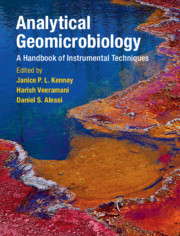Book contents
- Analytical Geomicrobiology A Handbook of Instrumental Techniques
- Analytical Geomicrobiology
- Copyright page
- Contents
- Contributors
- Foreword
- Part I Standard Techniques in Geomicrobiology
- Part II Advanced Analytical Instrumentation
- Part III Imaging Techniques
- Part IV Spectroscopy
- 9 X-ray Diffraction Techniques
- 10 Application of Synchrotron X-ray Absorption Spectroscopy and Microscopy Techniques to the Study of Biogeochemical Processes
- 11 Bacterial Surfaces in Geochemistry – How Can X-ray Photoelectron Spectroscopy Help?
- 12 Applications of Fourier-transform Infrared Spectroscopy in Geomicrobiology
- 13 Mössbauer Spectroscopy
- Part V Microbiological Techniques
- Index
- References
9 - X-ray Diffraction Techniques
from Part IV - Spectroscopy
Published online by Cambridge University Press: 06 July 2019
- Analytical Geomicrobiology A Handbook of Instrumental Techniques
- Analytical Geomicrobiology
- Copyright page
- Contents
- Contributors
- Foreword
- Part I Standard Techniques in Geomicrobiology
- Part II Advanced Analytical Instrumentation
- Part III Imaging Techniques
- Part IV Spectroscopy
- 9 X-ray Diffraction Techniques
- 10 Application of Synchrotron X-ray Absorption Spectroscopy and Microscopy Techniques to the Study of Biogeochemical Processes
- 11 Bacterial Surfaces in Geochemistry – How Can X-ray Photoelectron Spectroscopy Help?
- 12 Applications of Fourier-transform Infrared Spectroscopy in Geomicrobiology
- 13 Mössbauer Spectroscopy
- Part V Microbiological Techniques
- Index
- References
Summary
X-ray diffraction techniques provide information regarding the formation and alteration of mineral phases that is critical for assessing geomicrobial processes. Of particular interest is the use of powder X-ray diffraction (pXRD) to identify unknown solid-state materials, determine the particle size of nanoscale mineral phases, and refine structure characteristics, such as unit cell parameters and atomic positions. The goal of this chapter is to provide practical knowledge for the successful preparation of solid mineral samples, optimal data collection strategies, and analysis of diffractograms collected from pXRD experiments. Specific uses of pXRD techniques in geomicrobiology are discussed to demonstrate the importance of diffraction in advancing our understanding of microbial communities in geologic systems.
Information
- Type
- Chapter
- Information
- Analytical GeomicrobiologyA Handbook of Instrumental Techniques, pp. 215 - 237Publisher: Cambridge University PressPrint publication year: 2019
References
9.6 References
Accessibility standard: Unknown
Why this information is here
This section outlines the accessibility features of this content - including support for screen readers, full keyboard navigation and high-contrast display options. This may not be relevant for you.Accessibility Information
- 8
- Cited by
